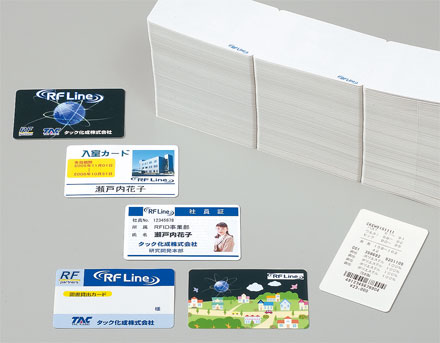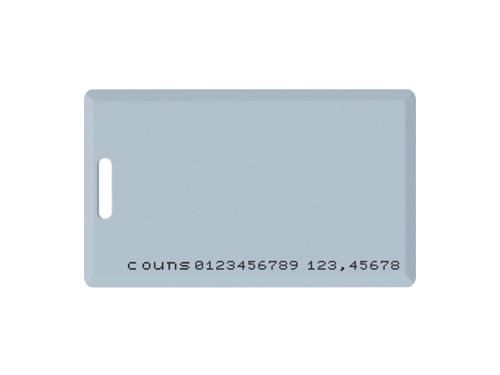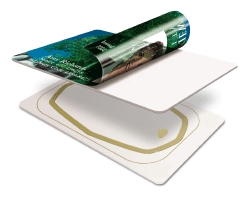RFID cards have been around for many years in various forms and mostly used in access control, security and financial applications. The technology utilized was most likely proprietary to their supplier and no open systems had existed. Most of these cards used passive RFID techniques in the frequency range of 125kHz to 135kHz. These cards were considerably thicker than most common photo ID cards, much more expensive, had limited memory space and could only be read one at a time.

Most utilization of RFID cards involved “proximity”- “contact-less” cards. These cards replaced the popular contact cards that used actual metallic contacts on its surface, or embedded ferro-magnetic wires for communications. The “proximity” card applications provided a high degree of security, however the performance range of the card was typically limited to a couple of inches, at most.
During the past few years numerous standards have emerged and are currently being adopted by the RFID transponder manufacturers. ISO 14443 for “proximity” cards and ISO 15693 for “vicinity” cards, both recommend 13.56 MHz as its carrier frequency. These standards feature a thinner card, higher memory space availability and allow numerous cards in the field to be read almost simultaneously using anti-collision, bit masking and time slot protocols.
ISO 14443 proximity cards offer a maximum range of only a few inches. It is primarily utilized for financial transactions such as automatic fare collection, bank card activity and high security applications. These applications prefer a very limited range for security.
ISO 15693 vicinity cards offer a maximum usable range of out to 28 inches from a single antenna or as much as 4 feet using multiple antenna elements and a high performance reader system.

RFID Inlay
The manufacture of the card starts with the “inlay” or “foil” which contains the metallic antenna loop, silicon chip and associated components. Dynasys specializes in supporting Texas Instruments HF-I Tag-It inlays. These 13.56 MHz inlays meet ISO 15693 specifications and come in various sizes.
The PVC card itself typically meets the dimensions according to ISO 7810. An ISO card is 85.6mm long, by 54mm high, by .76mm thick.
ISO specification allows for a punchable area along the horizontal edge and a punchable area along the vertical edge without causing damage to the internally laminated RFID inlay. These punchable areas may limit the size of the inlay that can be used in the card. If the application does not require a punched hole in the card a larger inlay may be desired to attain optimum range performance.
Dynasys provides cards, laminated with various inlay sizes:

- 22.5mm x 38mm – Miniature Rectangle
- 35mm x 65mm – Access Control Rectangle
- 45mm x 45mm – Square
- 45mm x 76mm – Large Rectangle
High Performance Cards
Getting maximum range from an ISO 15693 vicinity card, referred to as an “ISO” card for short, requires the proper integration of RFID reader, RFID antenna system and choice of card inlay.
In order to obtain optimum range from a passive RFID card the largest inlay size typically offers the best range. The magnetic flux energy from the radio field of the reader induces currents in the conductors of the inlay. Typically, the larger the loop aperture of the inlay’s antenna, the more energy that is captured and usable by the tag.
The relative angle that the card is presented to the reader antenna is a major factor in the available coupling. Antenna systems can be designed for parallel or perpendicular coupling to the card. If the card presentation angle is random, every effort should be made to capture energy at various angles and positions in the field.
Consideration should be given whether the card will be used in a badge holder, mounted vertical or horizontal, with or without a lanyard, pocket clip or pin. Also, proximity to anything metallic may cause significant degradation in performance range.
Anti-collision protocols will allow multiple cards to be detected within a common field. Just how well multiple cards are handled is a function of the reader’s intelligence and the antenna’s field pattern.
Making the Right Choices
Choosing the proper components for an RFID system is far from a trivial undertaking. Many options exist for selecting the reader, antenna system, and reader software as well as choosing the optimum compatible card components.
There are numerous places to obtain technical information and get some familiarity on RFID technology. This site is a good start. We also offer numerous get-acquainted RFID kits in case you want to get some hands-on experience.
Plasticcardonline INC are expert in RFID technology and are available to you to answer any questions you may have. We will help you to design an RFID system that will work best for your application.


